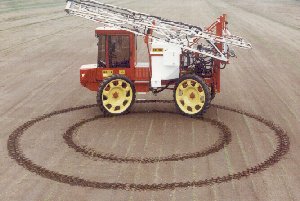![]()
Frazier Electronic Four Wheel Steering
Why 4WS
Four wheel steering greatly improves the maneuverability of the machine and improves the turning circle by about 40%. In addition the rear wheels will also follow the front ones so there is only one wheel track when turning. This is extremely advantageous when working in specialist crops and vegetable rows where tight turns are imperative.
When
The Frazier electronic four wheel steering system was originally developed in 1992 by the company's founder and managing director, Tony Frazier. We then became the first agricultural machinery manufacturer in the UK to market a system of this type on a self propelled sprayer. Since then at least 5 other manufacturers (including JCB) have also followed suit and incorporated systems on their own machines based on exactly the same principles.

Electronics have been used to overcome the problem normally associated with conventional four wheel steering systems i.e. the rear wheels creeping out of track. This problem occurs with natural oil leakage across the seals in steering rams and through the hydraulic control valves, and is one that cannot be easily overcome. This tendency is normally acceptable with industrial and loading machines and in this situation the problem can be overcome by using a simple electronic switch and valve arrangement to correct the rear wheel creep each time the wheels pass through the straight ahead position. However, this does not work when the machine is driven in a straight line for a relatively long period of time e.g whilst traveling from one end of a long field to the other whilst spraying. The problem is also compounded when the field happens to be on sidling ground - by the time the end of the field is reached the rear wheels are likely to be "crabbing" and two sets of wheel tracks will be evident. Electronics also make the system a lot more versatile and all sorts of steering modes such as crab steer and manual steering can be incorporated at minimal extra cost.
How it works
Each axle is fitted with a fully enclosed, waterproof, position sensor on top of one of the steering kingpins. When the front wheels are turned the voltage from the front sensor will increase or decrease depending on the direction of the turn and the steering angle. An electronic "brain" continuously monitors the voltage signal from each sensor. If the voltage differs between the two sensors then the computer sends a signal to an electronic, proportional spool valve which , in turn, diverts oil to the steering ram on the rear axle until the two voltage signals are matched and the rear wheels lined up with the front. This all happens instantaneously as the signals are monitored and corrections made hundreds of times every second so as you turn you get the impression that the steering on the two axles is physically connected. For the electronic control in the two wheel steering mode the front sensor is ignored and a signal is taken from a fixed voltage source. Should the rear wheels then try to creep through any oil leakage then a voltage difference will be seen and the rear wheels will be corrected to the straight ahead position.
|
The control panel The panel mounted control box has switches for power, mode selection and a lockable knob for rear axle manual steering. It also incorporates warning lights and various safety systems. A new "auto mode" is also now fitted to switch automatically from 2WS to 4WS as the sprayer is switched on and off. |
|
Steering Modes
|
|
Two wheel steer In Two Wheel Steer mode the rear axle position is monitored continually and fine adjustments are made by the system to ensure the wheels keep straight. You may switch to this position at any time in the field and the rear wheels will straighten up automatically regardless of the position of the front wheels. |
|
|
Four wheel steer In Four Wheel Steer mode the rear wheels will always follow the front ones and will give the tightest turning circle. You may switch to and from this position at any time in the field and the rear wheels will re-align automatically regardless of the front wheel position. |
|
|
Crab steer Crab steer may sometimes be useful when manoeuvering in buildings and in tight corners in fields. The rear wheels turn in the same direction as the front ones allowing the machine to move sideways. Again this mode can be selected at any time. |
|
|
Manual rear axle steer In Manual Steer mode the rear wheels can be steered manually and independently of the front ones. When in this mode the manual steering knob can be unlocked and rotated in the required direction to steer the rear wheels. This is useful for manoeuvering in tight corners and may also be useful to offset the rear wheels slightly when working on steep side banks to stop the rear of the machine from slipping downhill. |
|
|
Roadwork lock In the Roadwork position the electronics are deactivated for safety and the rear axle will lock. An audible alarm and red warning lamp are fitted in the control box which will both activate at speeds above 12 m.p.h. when in any of the other steering modes. |
|
Auto Mode ** New ** The latest control box has a new "auto mode" fitted. When selected the system will switch from 2WS to 4WS automatically as the sprayer is switched on and off for ease of steering down the field and for optimum turning on the headlands. |
| Homepage | Index | Products | Whats New |
| 3D | 4D | 475 | 5D | Stealth | Stealth HC |